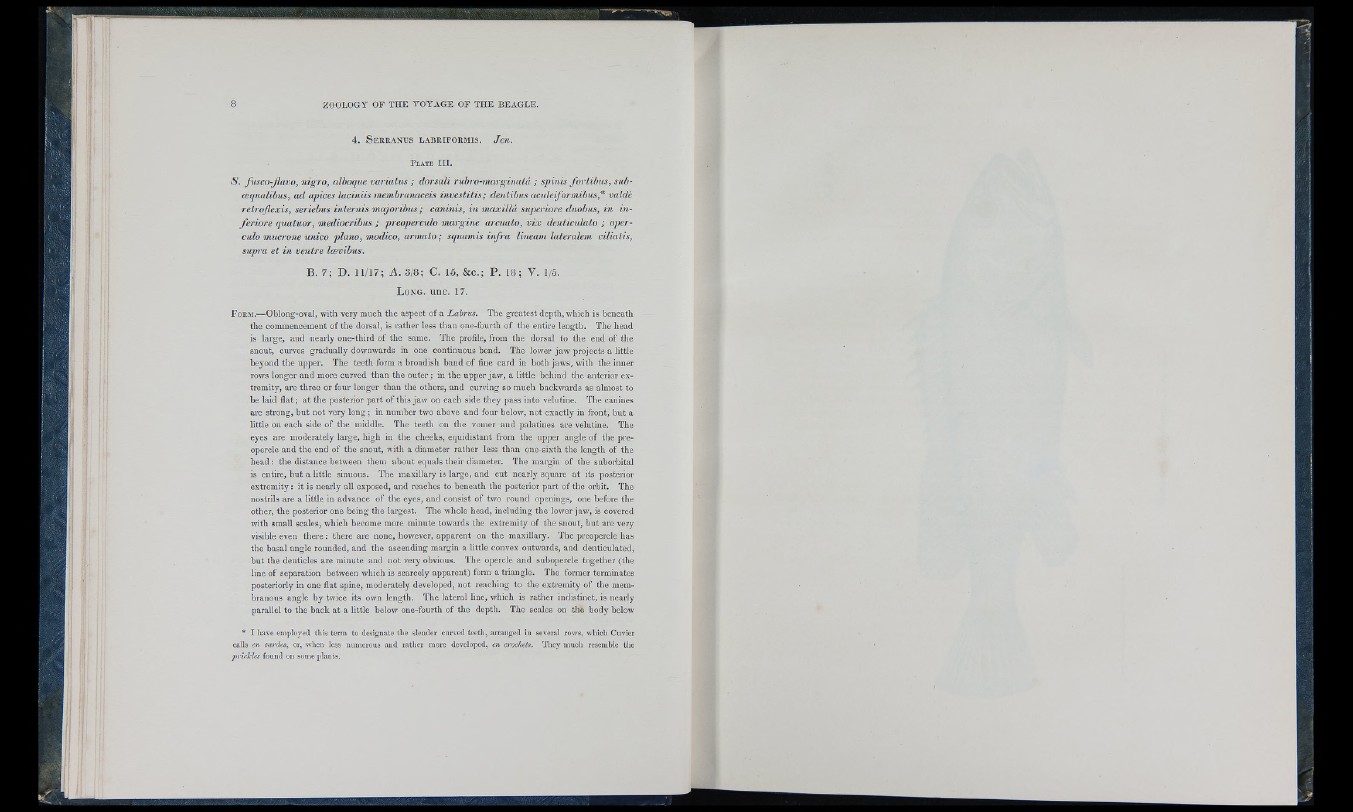
4 . S e r r a n u s l a b r if o r m is . Jen.
S. fusco-Jlavo, nigro, alboque variatus ; dorsali rnbro-marginatá ; spinis fortibus, snb-
(sqiialibus, ad apices laciniis membranaceis investitis; dentibus aculeifonnibus,* valdb
retroflexis, seriebus internis majoribus; caniiiis, in maxUlci superiore duobus, in inferiore
quatuor, mediocribus ; preoperculo margine arcnato, vix denticulato ; operculo
mucrone unico piano, modico, armato; squamis infra lineam luteralem ciliatis,
supra et in ventre lesvibus.
B. 7; D. 11/17; A. 3/8; C. 15, &c.; P . 18; V. l/o.
L o n g . u n c . 17.
F o rm .— Oblong-oval, with very much the aspect of a Lahrus. The greatest depth, which is beneath
the commencement of the dorsal, is ratlier less than one-fourth of the entire length. The head
is large, and nearly one-third of the same. The profile, from the dorsal to the end of the
snout, curves gradually downwards in one continuous bend. The lower jaw projects a little
beyond the upper. The teeth form a broadish band of fine card in both jaw s, with the inner
rows longer and more curved than the outer ; in the upper jaw , a little behind the anterior extremity,
are three or four longer than the others, and curving so much backwards as almost to
be laid flat; at the posterior p art of this jaw on each side they pass into velutine. The canines
are strong, b u t not very long; in number two above and four below, not exactly in front, but a
little on each side of the middle. The teeth on the vomer and palatines are velutine. The
eyes are moderately large, high in the cheeks, equidistant from the upper angle of the preopercle
and the end of the snout, with a diameter rather less than one-sixth the length of the
head : the distance between them about equals their diameter. The margin of the suborbital
is entire, but a little sinuous. The maxillary is large, and cut nearly square at its posterior
extrem ity: it is nearly all exposed, and reaches to beneath the posterior part of the orbit. The
nostrils are a little in advance of tlie eyes, and consist of two round openings, one before the
other, the posterior one being the largest. The whole head, including the lower jaw , is covered
with small scales, which become more minute towards the extremity of the snout, but are very
visible even th e re : there are none, however, apparent on the maxillary. The preopercle has
the basal angle rounded, and the ascending margin a little convex outwards, and denticulated,
b u t the denticles are minute and not very obvious. The opercle and subopercle together (the
line of separation between which is scarcely apparent) form a triangle. The former terminates
posteriorly in one flat spine, moderately developed, not reaching to the extremity of the membranous
angle by twice its own length. The lateral line, which is rather indistinct, is nearly
parallel to the back a t a little below one-fourth o f the depth. The scales on the body below
* I have employed th is term to designate th e slender curved teeth, arranged in several row s, w hich Cuvier
calls en cardes, or, w hen less num erous and rath er more developed, on crochets. They m uch resemble the
prickles found on some plants.